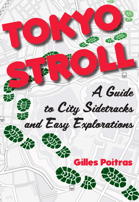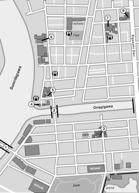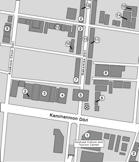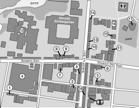











Tokyo Stroll Supplement: Mitakesan / Mt. Mitake

This page is a supplement page for the book Tokyo Stroll for day trips from urban Tokyo to Mitakesan
For information on Tokyo Stroll and this web supplement see Tokyo Stroll Supplement home page
For users of the Organic Maps, Maps.Me and Google Maps apps the items below have bookmarks you can import into those apps to make navigation easier.
Instructions and links are on the Viewing Locations in Organic Maps, Maps.Me, Google Maps, or Google Earth page.
Some entries on this page may include a note that says "Description to be added soon ." These entries are for items I felt should be listed even if the description is not ready to assist those who wish to plan a trip. When possible I included a link to an official web page, I suggest also doing web searchs for more information.
Mitakesan / Mt. Mitake (御岳山)
Mitakesan is located in the far west portion of Tokyo and within the Chichibu-Tama-Kai National Park. With an elevation of 929 meters (3,048 feet) Mitakesan is cooler than the rest of Tokyo so dress accordingly. There have been times when the peak still had snow in early spring. The mountain is not only known for lovely walking trails but Musashi Mitake-jinja which legend says was founded during the reign of Emperor Sujin in 91 B.C., over 2,000 years ago. There are also branch shrines in Japan such as Miyamasu Mitake Jinja in Shibuya (Tokyo Stoll p. 358).
NEAREST TRAIN/SUBWAY STATION: Mitake Station (JR Ōme Line)
CAUTION: There is a goodly amount of walking, some uphill, and there are many stairs involved in visiting Mitakesan. Expect stairs, lots of them, even at the top end of the cable car run before you get to the turnstiles. If you have trouble navigating stairs be prepared.
ACCESS:
For the entire route you can use a Pasmo or Suica card on the transit systems.
Rail portion: Budget about 1 1/2 to 2 hours for the ride. Take the JR Chūō Line (Rapid) to Tachikawa Station (JC 55), transfer to the Ōme Line to the JR Mitake Station (JC 69). Major Stations in central Tokyo for the Chūō Line include Shinjuku and Tokyo Station.
Note: Some trains split at Tachikawa Station with part of the train continuing on the Ōme Line towards Oku-Tama Station (JC 74) and the other part continuing on the Itsukaichi Line. Make sure you are on the portion of the train that is heading in the right direction and you won't have to transfer. Otherwise you need to transfer at Tachikawa Station to the Ōme Line.
Bus and Cable car portion: At the bus stop across from the station, the # 10 bus departures are twice hourly and timed with the train arrivals. Get off at the cable car station, Takimoto Station, at the foot of Mitakesan and take the Mitake Tozan Railway cable car to the upper station, Mitakesan Station.
WEB: The Ōme City Sightseeing Guide has a good section on just Mt Mitake:
https://www.omekanko.gr.jp/
Chimotoya (千本屋)
A restaurant on the street leading up to Musashi Mitake Jinja. Here you can enjoy a variety of food and snacks. The menu includes coffee is made with spring water collected daily from the mountain, deer curry made with fresh locally hunted meat, and konnyaku sashimi made from locally grown konnyaku-imo. You can also get postcards, small items, and local pickles.
WEB: http://mitakesan.com/syouten/chimotoya/index.html
Hatakeyama Shigetada-zō / Statue of Hatakeyama Shigetada (畠山重忠 像)
Hatakeyama Shigetada was a samurai in the late Heian and early Kamakura Periods. He was originally on the Taira side in the Genpei War but changed sides to the Minamoto clan at the battle of Dan-no-ura. The statue is located outside the Hōmotsuden (Treasure Hall) near the steps as you approach the Musashi Mitake Jinja.
Higashibaba (東馬場)
One of many shukubō, pilgrimage guest houses, in the village that these days also provide rooms for tourists and hikers. The building is now listed as a tangible cultural property of Tokyo, the present structure dates from 1866. Given the age of the building it can be cold in the winter, however they do have a traditional Japanese bath and portable heaters. Higashibaba has been owned and run by the Baba Family since 1659. The family is descended from Baba-no-Mino-no-Kami, one of the major generals of Takeda Shingen and reside at Higashibaba. This is also a Shintō priest family for Musashi Mitake-jinja.
During the day they serve tea, coffee, and traditional snacks as well as sell local crafts.
RESERVATIONS: To stay here advance reservations are required, a minimum reservation is for 2 adults, they only take one group of up to 10 people a day on weekdays. The proprietress speaks excellent English having studied in Brisbane Australia and London. 100% Nonsmoking.
CLOSED: Weekends and holidays.
WEB: https://higashibaba.com
Hōmotsuden / Treasure Hall (宝物殿)
The Treasure Hall on the grounds of Musashi Mitake Jinja which is open on Saturdays and Sundays houses many items including swords, saddles, and armor donated by warriors. One special piece is the akaito odoshi yoroi (red-thread-armor) offered to the shrine by Hatakeyama Shigetada in 1191 which is now designated a national treasure.
Korisan (古狸山)
A tanuki-themed cafe housed in a building from the Taishō Era.
The name of the cafe means "old tanuki mountain." The menu includes coffee, tea, tororo soba, udon, of course also including tanuki udon, also Japanese sweets such as warabi mochi, and anmitsu. Outdoor seating is available for relaxing with your pet.
WEB: http://mitakesan.com/syouten/korisan/
Mitake Tozan Kēburu / Mitake Tozan Cable (御岳登山ケーブル)
A funicular line operated by the Keiō Group running between Takimoto Station, the lower station, and Mitakesan Station, the upper station. Takimoto Station has a shop selling a variety of goods including locally grown fresh wasabi. At the upper station there is also a small shop where you can find mountaineering goods, craft, and other items. They are said to also sell wild boar curry. Construction on the line began in 1927 and the stations were opened in 1935. Operations were suspended in 1944 during WWII when part of the line was scrapped for war material. The line resumed in 1951. The upper station should not be confused with the Mitake Station in Ōme.
Musashi Mitake Shrine / Musashi Mitake Jinja(武藏御嶽神社)
Mitake Shrine was once called Mitake Zaō Gongen as the Priest Gyōki enshrined Zaō Gongen there in the 8th year (736) of the Tenpyō Era. A shrine was well established here before then as the shrine site is said to be over 2000 years old. For much of its history the shrine was heavily associated with Shugendō. In 1868 the government issued the Kami and Buddhas Separation Order (神仏判然令, Shinbutsu Hanzenrei) which resulted in Buddhist elements being removed and the name of the shrine changing to Mitake-jinja Shrine in 1874. In 1952 the shrine was renamed Musashi Mitake Jinja. The main shrine was constructed in 1878 in a very old shrine style.
NOTE: The stairway to the shrine is said to have 300 steps. At three spots there are carvings of oni beneath some of them.
ACCESS: Located about a 30 minute walk from the upper cable car station through the village and look for the large torii at the base of stairways.
WEB: http://musashimitakejinja.jp/homotsu_multilingual/en/en-top.html
Oshi-shūraku, Oshi Village (御師集落)
Close to the top of Mitakesan is this village composed of the homes of Shintō priests and of businesses catering to pilgrims, tourists, and the local population. There are of course, restaurants, souvenir shops and inns where you can stay overnight called shukubō (宿坊). I only cover a few in this web page. Shukubō are guest houses, originally for pilgrims but these days also for other visitors. There are 25 of them in the village and many of the shukubō date back to the 17th century. Shukubō are run by oshi, that is families who are affiliated to a certain temple or a shrine who take care of pilgrims. The oshi at Mt. Mitake are different than most others as the families are all also headed by Shintō priests.
Tokyo Mitake Visitor Center / Tōkyōto Mitake bijitāsentā (東京都御岳ビジターセンター)
The visitor center is located roughly half way between the upper cable car station and Musashi Mitake-jinja. Here you can obtain detailed maps of the many hiking trails and other information concerning the area. There are also exhibits concerning the mountain and a place where you can eat and drink. The center has a focus on nature, conducts educational programs, tours and more.
CLOSED: Year end and New Year's, Mondays unless Monday is a holiday in which case they close on Tuesday.
WEB: https://www.ces-net.jp/mitakevc/
Ubuyasusha (産安社)
This branch shrine for Musashi Mitake Jinja is said to have been founded by Miyamoto no Yoritomo in the 12th century. This shrine is located not far from the upper cable car station, Mitakesan Station. However you have to take one of the local trails to reach it. At this shrine are three sacred sugi (cypris) trees identifiable by the rice stray ropes and steamers attached to them. Meotosugi is actually two trees and as a couple pass between them if the man touches the "female" tree , the one with bumps, and the woman touches the "male" tree they will have a good relationship. The "child giving cypress" has a split root and a magatama shaped bump. The third, the Asansugi, has several branches coming off the trunk and grants easy birth, healthy children and longevity.
WEB: http://musashimitakejinja.jp/oyashiro/ubuyasu/
Back to the Tokyo Stroll Supplement home page - Privacy Notice - Back to Gilles' home page
Created August 2, 2023 | Content last updated April 20, 2025